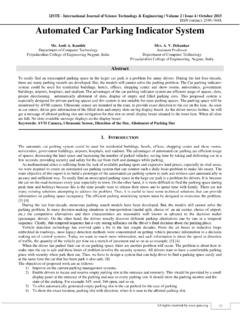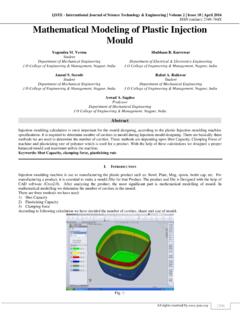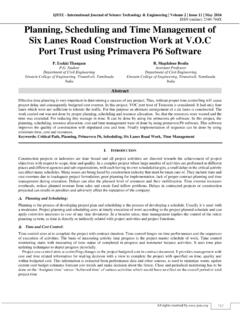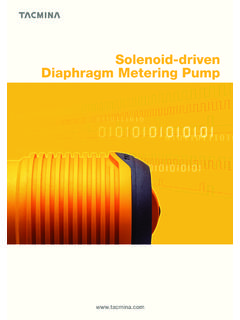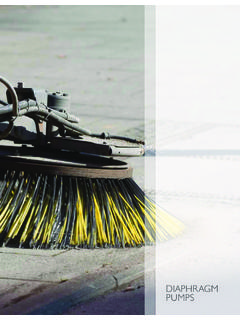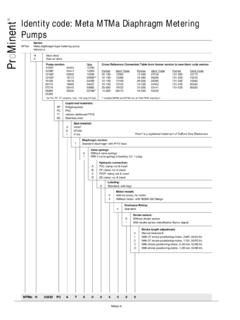Transcription of Design and Analysis of Diaphragm Spring of a Single Plate ...
1 IJSTE - International Journal of Science Technology & Engineering | Volume 2 | Issue 12 | June 2016 ISSN (online): 2349-784X All rights reserved by 26 Design and Analysis of Diaphragm Spring of a Single Plate Dry Clutch Abhijit Rupnar Aditya Babar UG Student UG Student Department of Mechanical Engineering Department of Mechanical Engineering Smt. Kashibai Navale College of Engineering, Pune Smt. Kashibai Navale College of Engineering, Pune Akash Karale Sanket Gundawar UG Student UG Student Department of Mechanical Engineering Department of Mechanical Engineering Smt.
2 Kashibai Navale College of Engineering, Pune Smt. Kashibai Navale College of Engineering, Pune Abstract A Clutch is a machine element used to connect a driving shaft to the driven shaft, so that the driven shaft can be given power or stopped at wheel, without stopping the driving shaft. Clutches are designed for the transfer of maximum torque from the engine with minimum heat generation. During engagement and disengagement the two clutch discs have an axial sliding motion between them. The clutch is allowed to engage the transmission system gradually only with a certain amount of slippage between the flywheel and the pressure Plate .
3 The paper contains the designing and Analysis of Diaphragm Spring used for the generation of clamping load. The Design of Single Plate clutch is done for Force Motors New Vehicle and is drawn by using theoretical calculation results. For designing of the Diaphragm Spring , 3d modelling software used is CATIA Structural Analysis is done to find the stress distribution on the model. With the Analysis results, we check whether the Design is safe or not, comparing the result with theoretical calculation and theoretical results.
4 For structural Analysis HYPERMESH software is used. Keywords: Clutch Clamp Load, Diaphragm Spring , Dry Clutch, Single Plate Clutch _____ I. INTRODUCTION In clutch cover assembly, the Diaphragm Spring is installed between the pressure Plate and the cover stamping, or cover casting. The Diaphragm Spring contracts the cover stamping (or cover fulcrum elements) and pressure Plate at specific fulcrum diameters. In this configuration the Diaphragm Spring creates a clamping load through the pressure Plate fulcrum and provides a lever ratio B/A, through which a release load R can be applied to disengage the clutch (clamp load).
5 Clamp load and release load are related through the lever ratio, as are pressure Plate travel and release bearing travel. Understanding these load and travel relationships will form the basis for understanding the basic functioning of the Diaphragm Spring clutch. The release bearing contacts the Diaphragm Spring levers at a specified contact diameter. The pressure Plate contacts the Diaphragm Spring at a specified fulcrum diameter. The force of the Diaphragm Spring (clamp load) is transferred through the pressure Plate at his point, known as the pressure Plate fulcrum.
6 This point is also sometimes called the cam, because of the motion of Diaphragm Spring over this area. The pressure pate stays in contact with the Diaphragm Spring through the force of clutch cover drive straps, or by clips which physically hold the Diaphragm Spring to the pressure Plate II. FUNCTION OF Diaphragm Spring The clamping force on the friction facings is provided by the Diaphragm Spring . The Diaphragm Spring is a steel disc having a hole at the center, and the inner portion of the disc is radially slotted so that a number of actuating (release-lever) fingers are formed.
7 The outer ends of the slots are provided with enlarged blunting holes, which distribute the concentrated stresses created during deflection of the fingers, and also provide a means of locating the shouldered rivets, which restrain the fulcrum rings. Unloaded, it is a dished shape. As the pressure Plate cover tightens, it pivots on its fulcrum rings, and flattens out to exert a force on the pressure Plate , and the facings. The transmission input shaft passes through the center of the pressure Plate . Its parallel splines engage with the internal splines of the central hub, on the friction disc.
8 With engine rotation, torque can now be transmitted from the flywheel, through the friction disc, to the central hub, and to the transmission. When the clutch pedal is depressed, the movement is transferred through the operating mechanism, to the operating fork and the release bearing. The release bearing moves forward and pushes the center of the Diaphragm Spring towards the flywheel. The Diaphragm pivots on its fulcrum rings causing the outer edge to move in the opposite direction and act on the pressure- Plate retraction clips.
9 The pressure Plate disengages, and drive is no longer transmitted. Releasing the pedal allows the Diaphragm to re-apply its clamping force and engage the clutch, and drive is restored. Design and Analysis of Diaphragm Spring of a Single Plate Dry Clutch (IJSTE/ Volume 2 / Issue 12 / 007) All rights reserved by 27 III. CLAMP LOAD CALCULATION The axial force required for transmitting the torque is known as the Clamp load. An estimation of the axial force can be computed by means of the following analytical approach.
10 Considering an annular surface for the friction disk with inner radius ri and external radius r0, the axial force F and the transmitted torque T can be computed as function of the normal pressure p on the disk. The hypothesis of constant pressure is usually valid for new clutches, while the hypothesis of constant wear is valid for worn clutches. Under the hypothesis of constant pressure, the axial force can be computed as F = 3T2k (ro2 ri2)(ro3 ri3) .. (1) Where, being the friction coefficient, k the number of disk surfaces (k=2 for a clutch with just one disk).

